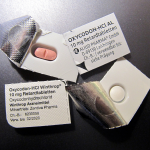Senators Michael Bennet and Susan Collins co-sponsored the bill passed last December to combat the overdose crisis. While the bill had some good features, some will make matters worse. That’s because lawmakers refuse to accept the evidence and still cling to erroneous beliefs about the root causes of the crisis.
oxycontin
Since 2020 Dr. Roneet Lev has been doing podcasts called High Truths, most often about addiction and drugs. So, I was happy to participate in an episode about fentanyl. It turned into quite a bit more.
The $21 billion settlement between the attorneys general of several states and pharmaceutical distributors will make the lawyers rich (they get roughly 10 percent of the total) but will do nothing to affect overdose rates. Dr. Jeffrey Singer tells us why.
Purdue Pharma will pay an $8 billion fine and shut down. Finally, justice has been served, though far too late for the thousands of addicted or dead Americans whose problems began with OxyContin.
In 2017, more than 72,000 Americans died from drug overdoses. That's a staggering number -- almost double the number of car crash fatalities and nearly quadruple the number of homicides. Most drug overdoses involved some type of opioid.
The dominant media narrative is that unscrupulous pharmaceutical companies and careless doctors are to blame. But this is only one part of a multifaceted problem, and a rather skewed perspective at that. The reality is that recreational drug users are driving the crisis, not pain patients.
To understand how we arrive at that conclusion, a brief history of the opioid crisis is in order.
The Trump Administration has convened a panel to address America's opioid epidemic. Its first mission should be to find convincing data to identify the actual cause(s) of the problem. That will be much harder than it sounds, since ideologues are always in plentiful supply.
The overdose epidemic sweeping the nation is hitting some demographics harder than others. Heroin overdose deaths began to skyrocket in 2010. New data shows that of all groups, older millennials, those aged 25-34, are the likeliest to die from a heroin overdose.
Even in 2015 over 100 years after aspirin and heroin were discovered there's still no good (or even acceptable) way to treat pain, especially when it's chronic and severe. This unmet medical need is now a very hot topic, especially since the FDA recently approved OxyContin for children.
It is hardly news that the US is plagued by an enormous narcotic addiction problem. Nor is it news that the so-called war on drugs has been an abysmal failure since its inception.
One of our (many) pet peeves at ACSH is that not only does the press publish results of junk science as if they were undeniably true, but they also frequently write headlines that contradict the already-dubious results of whatever study they may be covering.
Dr. Josh Bloom on Science 2.0, March 3, 2015
I never know what I'm going to find on the editorial pages of the New York Times. Sometimes I agree with them, and sometimes I don't. But, they usually, at the very least, make sense.
If you are suffering from moderate-to-severe pain, you can add one more worry to your list the real possibility is that you will not be able to get effective pain-relieving drugs without considerable effort. And maybe not at all.






